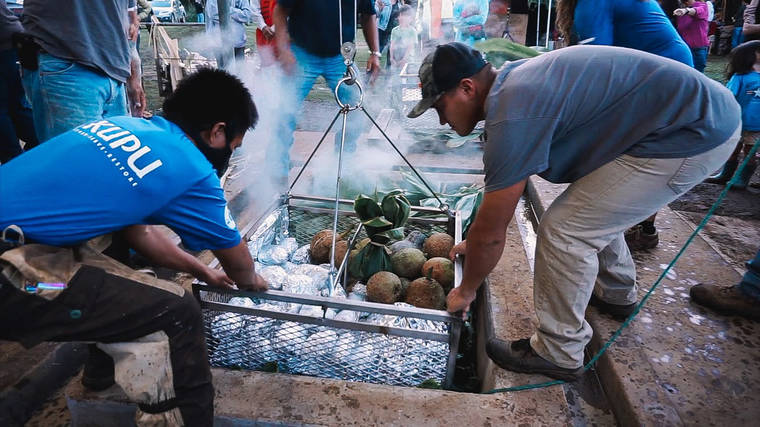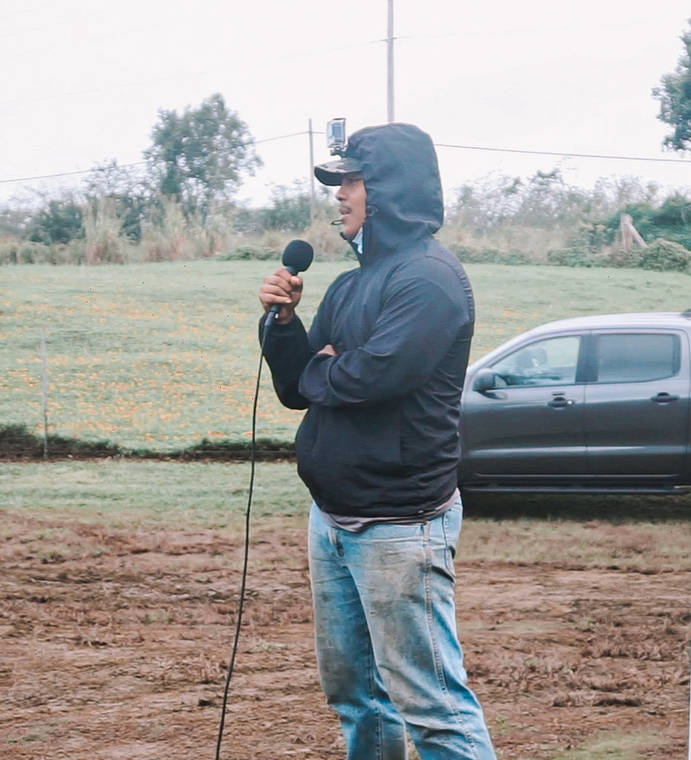North Kohala inaugurated a commercial imu in a ceremony in late November that advanced a years-long dream of local residents to help make the community food-sustainable, tapping a grant that had its origins in the 1964 Tokyo Olympics, when Native American Billy Mills staged an upset victory in the men’s 10,000-meter race.
Seventeen-year-old Kapaau resident Aukea Ka’aekuahiwi received a $10,000 grant from Running Strong, the organization established by Mills to support Native American youth and others, and used the funds to build the imu on a 5-acre family owned property in Kapanaia. The imu — an underground oven using volcanic rocks — will be available to families in the community for pig roasts for their relatives and for commercial sale of foods such as lau lau and kalua pig.
“A couple of years ago, we had the opportunity to go to Washington, D.C., to receive the grant. We had to explain what we would do with the money,” Ka’aekuahiwi told about three dozen people wearing masks as they gathered at the site. “The project would make a sow pen, and make a cooker, and also something that could give back to the community, so we thought of the imu to have a place that allows us to sell to the general public as well as for home use.”
Amid a light drizzle on Thanksgiving eve, the imu structure was given a Hawaiian blessing by Kahu Kealoha Sugiyama, who is also a board member of Kahua Pa’a Mua, a Kapaau-based nonprofit organization that is another sponsor of the project. The blessing is a customary step to humbly ask akua (god) for wisdom and guidance ahead of the trial run, which was necessary before state health officials come to inspect and officially certify the imu.
“We are so blessed in Kohala with the sweet breath of the sun, the rain that has been falling on the aina, bringing new growth, new opportunities. Look how green and lush our pastures are because of this rain, and we say mahalo,” Sugiyama said before offering a traditional blessing in chant. He noted Hawaiians are in the makahiki season, which runs from October through February.
Sugiyama invoked the ancestors to enjoy the celebration and passed around a makana (gift) — including sweet potato, Hawaiian sea salt, and a banana wrapped in ti leaves, with their symbolic meanings. He asked each attendee to add their mana before placing the makana inside the imu.
“When the food is ready to be placed in the imu, I want the makana, your gift of aloha, to be in it. Every time something is cooked in this imu, the gift of aloha will be in it,” he said.
Councilman Tim Richards told the residents he was gratified to see the project come to fruition after “talking story for a long time.”
“The last year has been tough, but Kohala is strong and resilient and this is a step in the right direction,” he said. “The comments about Kohala striving and seeking food self-reliance and food security, it starts with us trying to take care of ourselves first. And these are the steps that Kahua Pa’a Mua are taking to develop programs to teach the young, but we also need the facilities to embrace what we are teaching.”
After his thrilling come-from-behind Gold Medal run in Tokyo, Billy Mills used his fame to inspire Native Americans to believe in themselves and chase their dreams. In 1986, he co-founded the non-profit Running Strong for American Indian Youth organization. Since 2014, on the 50th anniversary of his race, the organization began awarding 10 grants annually of $10,000 each to help young people achieve their dreams.
“This started five years ago when students in the HA program — Ho’o Kahua Ai — they come every other weekend to work with mentors on natural farming, crops and animal husbandry. That’s how they got their start raising pigs,” said Carol Fuertes, an officer of the board of Kahua Pa’a Mua. The organization aims to pass on traditional farming and animal husbandry methods by pairing students with tutors, with the goal of having families raise their own food and sell their excess in the community.
North Kohala has achieved significant progress, despite the recent COVID-19 challenges, toward a goal of supplying 70% of food from locally grown sources.
“In North Kohala, where Kamehameha the Great was born, we know that we have the resources and food sources here to supply our community, so one of the main goals was to bring back their culture and implement some of those things with our culture and use this imu as a resource for our community,” said Davey Fuertes, a cattle rancher who is the son of David and Carol.
Traditional Hawaiian imu cooking incorporates layers of wood, lava rock, banana stumps and ti leaves, moistened burlap, and covered with dirt to hold in the steam and heat. The pig or other meats and fish and vegetables typically cook for hours in this way and when the layers are peeled off, the meats are moist and tender.
The Kohala imu added some modern touches, both to meet state sanitary requirements and for conveniences. For instance, the pit is sealed in concrete and uses mechanized stainless steel crates to lower the food into the pit. And a layer of plastic is added at the top instead of dirt for sanitary reasons.
“It all starts with a dream, whether it is 20 years old, a year old, or someone who has passed it down,” said Davey Fuertes. “And you see if front of us — I see dad over there smiling because this was his dream.”
Standing quietly in the background, David Fuertes was beaming, proud that his teachings were being taken up by a new generation.
On Thanksgiving morning, organizers delivered a food platter from the imu to each of the attendees, complete with the aloha from the makana that had been added to the mixture.


